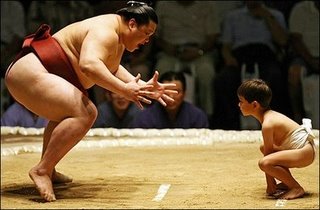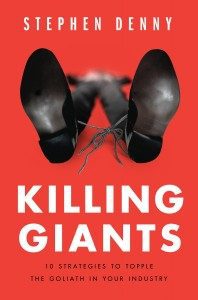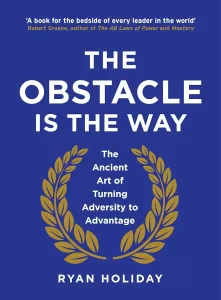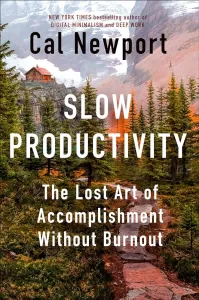Book Review: “Killing Giants”
Book: Killing Giants by Stephen Denny
Reviewer: Bobby Powers
My Thoughts: 7 of 10
Killing Giants teaches you how to use small size to your advantage. Stephen Denny shares ten tips and dozens of stories of how "little guys" exploited the bureaucracy and slowness of their biggest competitors to carve out their own niche and become profitable. This book is life-giving to any young entrepreneur or startup company that feels helpless when viewing their competitive landscape.
Takeaways from the Book
10 Tips for Killing Giants:
1) Thin Ice - Pick a fight in a place where they can’t beat you
- “Thin Ice is dangerous to companies who are too big to venture far from the relative safety of familiar ground...But you know the ice can support your weight. You made this patch of ice in the first place. So taunt the giant all you want. When we create our own Thin Ice, we change the environment to suit our needs. We move the public dialogue to a place where the giant is unprepared to go.”
- Jim Koch from Boston Brewing Company (maker of Samuel Adams): “Could a giant do what we do? It’s not impossible. It’s difficult because it’s not what they’re good at. They’re good at cost-effectively mass-producing beers that appeal to the mass market. They could make craft-styled beers if they put their minds to it. But it’s hard for a big company to care about such specialized products. It’s not outside their capabilities, but it’s like McDonald’s. Could McDonald’s make filet mignon? Of course, but it’s not the business they’re in.”

2) Speed - You are quicker and more maneuverable; take advantage
- "Strive to move so fast that you’re on iteration five or ten before the giants can even enter the market. They’re slowed down by bureaucracy, meetings, and corporate red tape. You’re not."
- “There’s no time or sympathy for second guessing. Make a decision and let’s execute to the best of our abilities toward that goal.”
3) Win in the Last Three Feet - Smart brands find ways to leverage other people’s investments
- “In every transaction, there’s a moment just after the giant thinks he’s got the sale and just before the customer hands over their money. This gap is an opportunity for a smart, agile competitor to snatch victory from the jaws of defeat. Winning in the Last Three Feet is an old retail expression, but it speaks universally to the idea of understanding that it’s never over until it’s over…Those last three feet are where giant-killers live.”
- “Winning in the Last Three Feet requires that we understand how our customer makes decisions—where they look for information, what they value the most, and exactly when they will be committing their money.”
4) Fight Dirty - Pick the fight you can win and fight by your own rules
- “Competing with giants on an equal footing, under the same assumptions and playing by the same rules, is a losing game.”
- “Question the givens. One of the greatest tools we have at our disposal is our ability to judiciously question what we at first assume to be unquestionable.”
5) Eat the Bug - Up the ante in a game they don’t want to play
- “Learn to love what the giant considers taboo. Be willing to do what they aren’t and build a business out of it, every day. Go ahead. Do the unthinkable. Eat the bug.”
- “Giants have little to gain by publicly taking on a minor player. You, on the other hand, have everything to gain: publicity, validity, and the sure knowledge that giants don’t want this much attention. The court of public opinion tends to side with the underdog.”
6) Inconvenient Truths - Make the math hurt; implement new pricing strategies
- Giants assume the win. They figure that nobody ever got fired for buying from the big player in the market. Change the math of the transaction by packaging your deal differently than the Giant.
- “How can you change the shape of the transaction to make the sale in a more palatable way? Challenge the givens…Change the shape of the transaction. From ‘bottom of the pyramid’ example of single-serving-size packets of detergent to the fractional ownership model for luxury executive jets, changing the shape of the transaction changes our expectations and lowers the barriers to acceptance.”
7) Polarize on Purpose - Don’t fit in and be polite; force people to make a choice
- “No one chooses you by accident. Force the decision. They’re either with you or against you. Polarize your market on purpose.”
- “Decide who you’re not. Polarizing your market for a reason means you accept the fact that not everyone is going to sing along with you. Some will be put off by what you’re doing. However, for those who see themselves in what you’ve created, you will have created a deeper sense of ‘we’ for every fan who’s in on the joke and how embraces the humor and the insider feeling of your brand. Instead of being safe and vanilla, you’ve decide to make a choice and be something more personal to a smaller group of hard-core customers.”
8) Seize the Microphone - Dominate the conversation with confidence and swagger
- “It doesn’t matter if you have one or more giants in your market. They may be big, but that doesn’t mean they’re leading the conversation…You don’t have to accept they you’re not big enough to be the industry spokesman, so naively grab the microphone and speak up for the whole industry. The giant hates this, but your customers love it.”
- “You will make yourself the spokesperson for the industry, so that anyone making a buying decision in your space has to actively pick you—or actively decide not to pick you. Regardless of their decision, you’re never going to be ignored.”

9) All the Wood Behind the Arrow(s) - Resoundingly win in a few key areas
- Pick one or two things to do better than any other company in your market. Ride those strengths to your success by relentlessly focusing upon them.
- “Winning in one particular spot means choosing to dominate a discussion the giant doesn’t want to contest.”
10) Show Your Teeth - Purse your competitive advantage vigorously
- “Marketers have to take risks. Well-informed, calculated risks. That’s what marketers need to do to cut through today’s clutter and get their message heard.” -Frances Allen
- “Give the elephant in the room a catchy and unfortunate nickname. Sometimes we find ourselves in a situation where the truth is hanging in the air and no one seems to want to say it. There is real power in articulating what everybody else is thinking. When you say, ‘Don’t pay the brand tax,’ you’re giving voice to what we all intuitively know.”
Other Notes
- “Once a company reaches a critical mass of size, they have different problems. Brands stop focusing on being good at what made them great and start being great at making much more of what they make.”
- “The longer a company is successful, the less they feel the need to revisit how they do what they do.”
- “Nobody likes to be forced to compete when they’ve got other things on their to-do list…giant-killers mess things up by laying down challenges that giants didn’t anticipate and see no glory winning."
Think you’d like this book?
Other books you may enjoy:
- The Art of the Start by Guy Kawasaki
- The Lean Startup by Eric Ries
- David and Goliath by Malcolm Gladwell
Other notable books by the author:
- (None)
Want to become a stronger leader?
Sign up to get my exclusive
10-page guide for leaders and learners.





